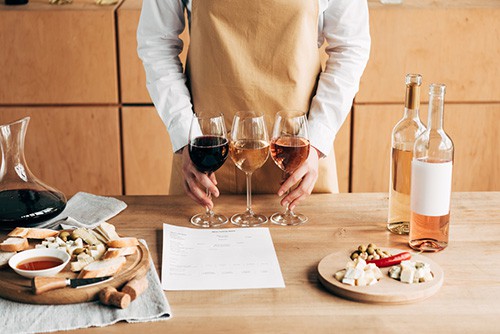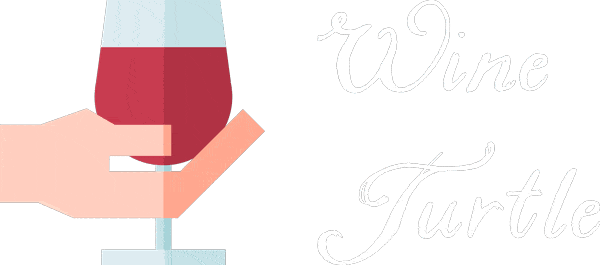The Order of Wine Tasting: How to Manage Your Palate

Tasting wine is supposed to be fun, but it also is an educational tool used to refine your palate and help you discern more flavors in wine.
It’s kind of like “studying,” but hopefully more enjoyable. That being said, it’s important that you set yourself up for success so you can gain a greater appreciation for wine.
While you can’t taste wine in a vacuum, you can coordinate your tasting experience to make it streamlined and limit competing flavors leaving you with palate fatigue.
After all, you wouldn’t study for a test in a crowded gymnasium, so why would you overwhelm your palate with competing flavors and aromas?
Each of these tried-and-true methods below are excellent tools to help guide you through your next wine tasting while keeping it fun, interactive, and thoughtful.
The Recommended Wine Tasting Order
In order to preserve your palate for longer, these are the accepted rules that most wine tastings follow.
Light-Bodied Before Full-Bodied
When we speak of light-bodied wines, this refers to wines that have a mouthfeel akin to skim milk, whereas full-bodied wines have more of a whole milk mouthfeel.
Starting with a lighter wine allows you to better appreciate the delicacy of that wine, before moving on to an overpowering full-bodied wine.
Example: Start with a light-bodied Pinot Noir before a full-bodied Cabernet Sauvignon.
White Before Red
Of all the “rules,” the concept of white before red is probably the one that is enforced the most.
This is because white wine is always going to be more nuanced in flavor, often with delicate flavor notes that you would do well to focus on, especially if you’re new to the world of wine tasting.
Subtle floral, tropical, or creamy notes can be overpowered if you were to start off with a red wine rich in berry and tobacco notes.
Example: Start with an aromatic white such as Viognier, before moving to a rich and complicated Syrah.
Young Before Old
Similarly to starting off with a lighter-bodied wine, you can expect most younger wines to have more bright fruit notes, such as a Gamay with flavors of fresh raspberries, or a Soave with bright lemon and green apple notes. Older wines tend to have more cooked fruit and earthy notes, which will overpower your palate.
Example: Sangiovese is best enjoyed young, but it would pale in comparison if tasted after its Italian cousin Nebbiolo, which is often aged for decades.
Related: Improve your wine tasting skills with these simple tips.
End on the Sweet Stuff
Dessert wines, many of which are fortified (grape spirits are added), are known for being powerful in flavor and rich in texture and body.
Therefore, they are best reserved for the tasting finale. This doubles as good advice for fortified wines which are high in alcohol and can lead to tipsiness, making for a dulled palate.
Example: Port is rich and powerful in flavor, and is best served as the grand finale so it can really shine. Decide if a tawny or ruby port is best for you with our guide.
Exceptions to the Rules
Now, the above mentioned rules are helpful in guiding you through a cohesive and enriching wine tasting.
That being said, every rule is made to be broken. Below are some common contradictions you might face when planning your next wine tasting.
Sparkling First, Even if it’s a Rosé
All good wine tastings begin with a little glass of sparkling wine. This is because it’s light, refreshing, low in alcohol, high in acid, and has a tiny bit of sweetness, which livens up the palate. Even if all you have is a sparkling rosé, it shouldn’t interfere with the order of your tasting, just continue with whites, then reds.
Dessert Wines at the End, Even if it’s a White
As mentioned above, we’ve already established that dessert wines should be served at the end of the tasting. This is because they tend to have a long-lasting flavor and enough sweetness to make the following wine taste bitter in comparison.
The same is true even if you were planning on serving a Sauternes or an Icewine as your final dessert wine. Dessert wines are last, no matter what!
Tips for a Successful Tasting
In addition to the order of wine tasting listed above, there are some good general rules of thumb to aid in making your next tasting a memorable one.
Use Palate Cleansers
As fun as it is to sit and drink wine all day, at some point you’re going to face palate fatigue, and get very drunk if you’re not careful.
To combat the palate fatigue, it’s good to keep some palate cleansers nearby so you and your guests can take a break and freshen your palate with either water, crackers, or even plain white bread.
Don’t Rinse Your Glass
You may feel compelled to rinse your glass with water in between tastings. Try to abstain from this practice. The reason is that most “tastes” of wine are around just 2 ounces, so even a few drops of water that remain in your glass can seriously dilute your wine, making for a poor-tasting experience.
Avoid Overwhelming Smells or Flavors
Strong perfumes, scented candles, or beverages such as coffee will drown out anything in your glass, and may even mislead you into perceiving incorrect aromas in the wine. If you’re hosting a wine-tasting party, kindly request your guests refrain from cologne or perfumes, and stick to water.
If You Really Want to Learn, Spit
Now, this usually throws some people off. After all, isn’t the point of wine to drink it?
Kind of, but if you really want to embrace the educational aspect of wine tasting and develop well-formed opinions of the wines you’re tasting, then it’s best to avoid drinking the wine, as you will inevitably end up intoxicated. Intoxicated palates get dulled, as do the palate-holder’s vocabulary skills.
To offer your guests a spitting vessel, you can opt for some small non-translucent cups. Or, if you really don’t like that idea, put a pitcher on the table so your guests can pour out the remaining wine in their glass, so they don’t feel compelled to finish each tasting.
Now that you’ve learned the perfect order of wine tasting, you should reward yourself, with wine! After all, this is supposed to be as fun as it is educational. If you ever find yourself uncertain, just think about it logically. Whites before reds, light-bodied before full-bodied, young before old, dry before sweet, and always start with sparkling.
